The concept of software-defined radio (SDR) has been around since the late 1980s with renewed interests every decade when technology makes leaps in signal processing and programmability.
The term “software-defined” covers a wide range of possibilities:
- Ability to select, via software, different functionalities from a set of prebuilt features,
- Ability to change, via software, functions or behaviors of the radio processing chain,
- The implementation of partial or complete capabilities in “software”
The ultimate flexibility of SDRs offers
- Future proofing hardware investment: enabling the piece of equipment to survive the test of time by allowing its core functions to be continuously updated
- Technology consolidation: allowing disjoint designs, concepts, technologies to be hosted by the same hardware, minimizing costs, maintenance, space, etc.
- Vendor lock avoidance: a single hardware platform that can be used by any vendor of unique signal processing functions, avoiding single-source supplier issues that lead to high costs, reduced quality, and diminished innovations.
Accelerated deployment: programmability and availably of flexible functions enable rapid deployment of newly invented, much needed functionality as demanded by the increasingly fast changing operational environments. New advancements can start making impacts in months instead of years.

Figure 1: Data/Signal Processing Chain for a Radio Network
Most SDRs support some programmable/adjustable aspects of the data flow in Figure 1, some more than others. Most of the programmability is concentrated on step #2 by using a programmable device such as a Field Programmable Gate Array (FPGA), a DSP device, or even a general-purpose processor paired with some low-level signal processing device. Allowing flexibility to steps #3 and #4 is, however, much more difficult, which is the reason most SDRs support a fixed setup for baseband/IF and RF frontend.
Cognicom Neptune SDRTM is a unique, true Software Defined Radio platform that offers programmability in all four areas in Figure 1:
- Software-Defined Network with dynamic flow control, multiple traffic type supports
- Programmable Capabilities for Advanced Signal Processing with high-performance, abundant resources
- Flexible baseband and IF processing that allows adjustable sample rates, tunable IF frequencies, flexible interpolation/decimation filtering, and so on.
- Dual Interchangeable RFEs with extremely wide instantaneous bandwidth (IBW) and a very wide tunable range for operational frequencies, coupled with support for TDD operations, dynamic gain controls for both TX and RX, feedback path for DPD implementation, and more.
